Abstract
The aspA gene of Escherichia coli W which encodes aspartase was cloned into the plasmid vector pBR322. The nucleotide sequences of aspA and its flanking regions were determined. The aspA gene encodes a protein with a molecular weight of 52,224 consisted of 477 amino acid residues. The amino acid sequence of the protein predicted from the nucleotide sequence was consistent with those of the NH2- and COOH-terminal regions and also with the amino acid composition of the purified aspartase determined previously. Potential promoter and terminator sequences for aspA were also found in the determined sequence.
Full text
PDF
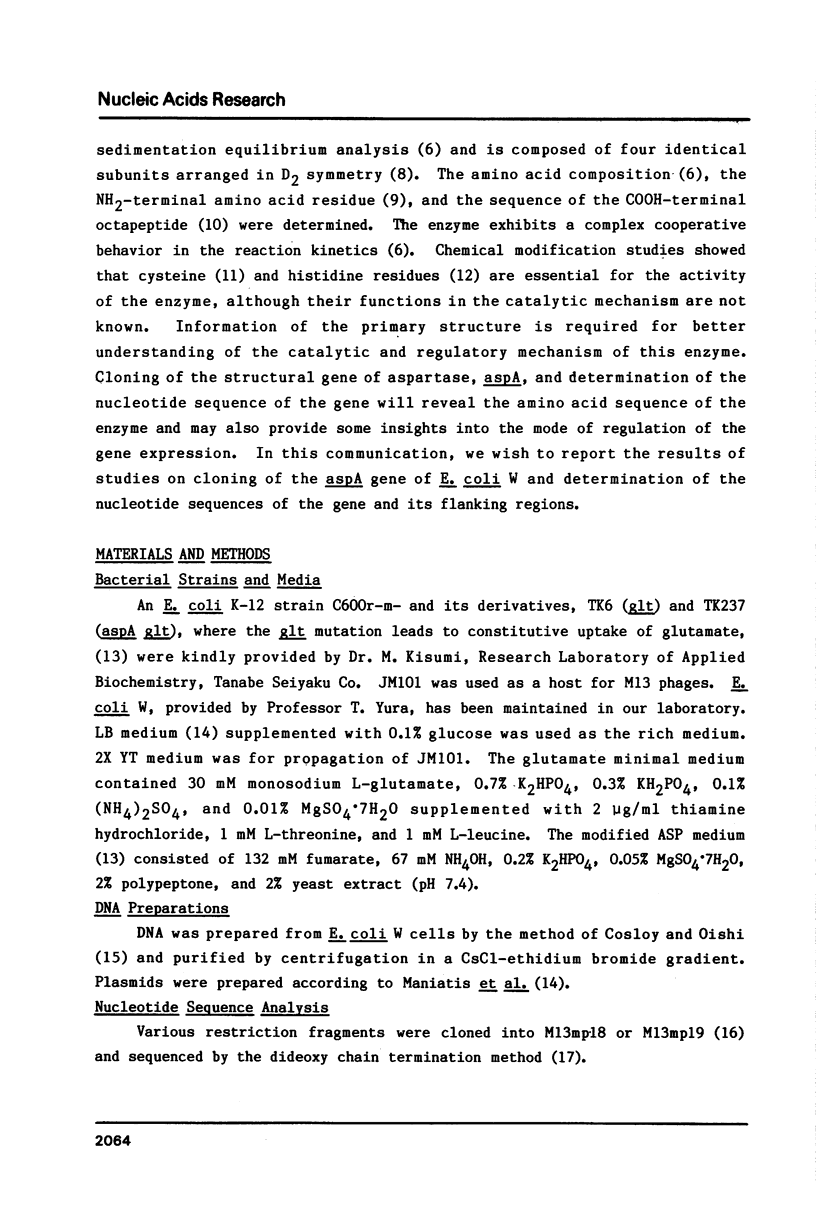
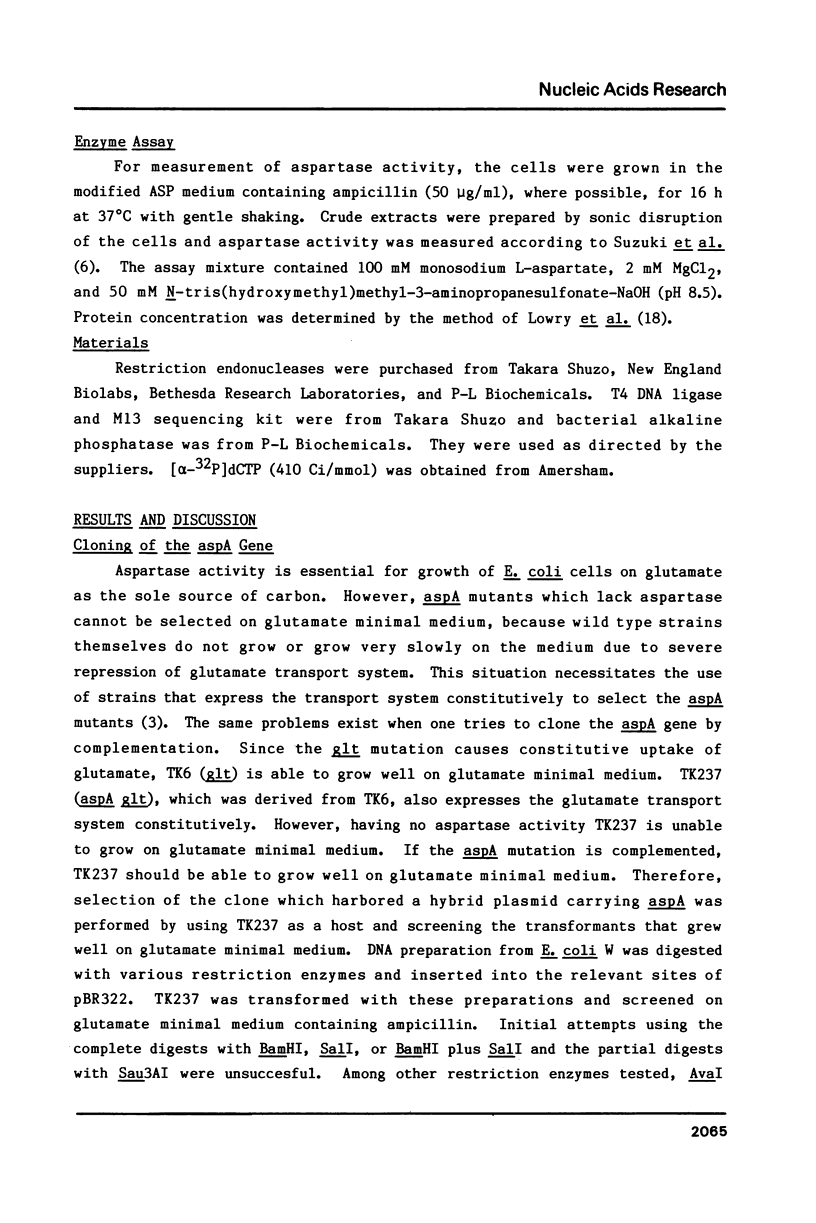
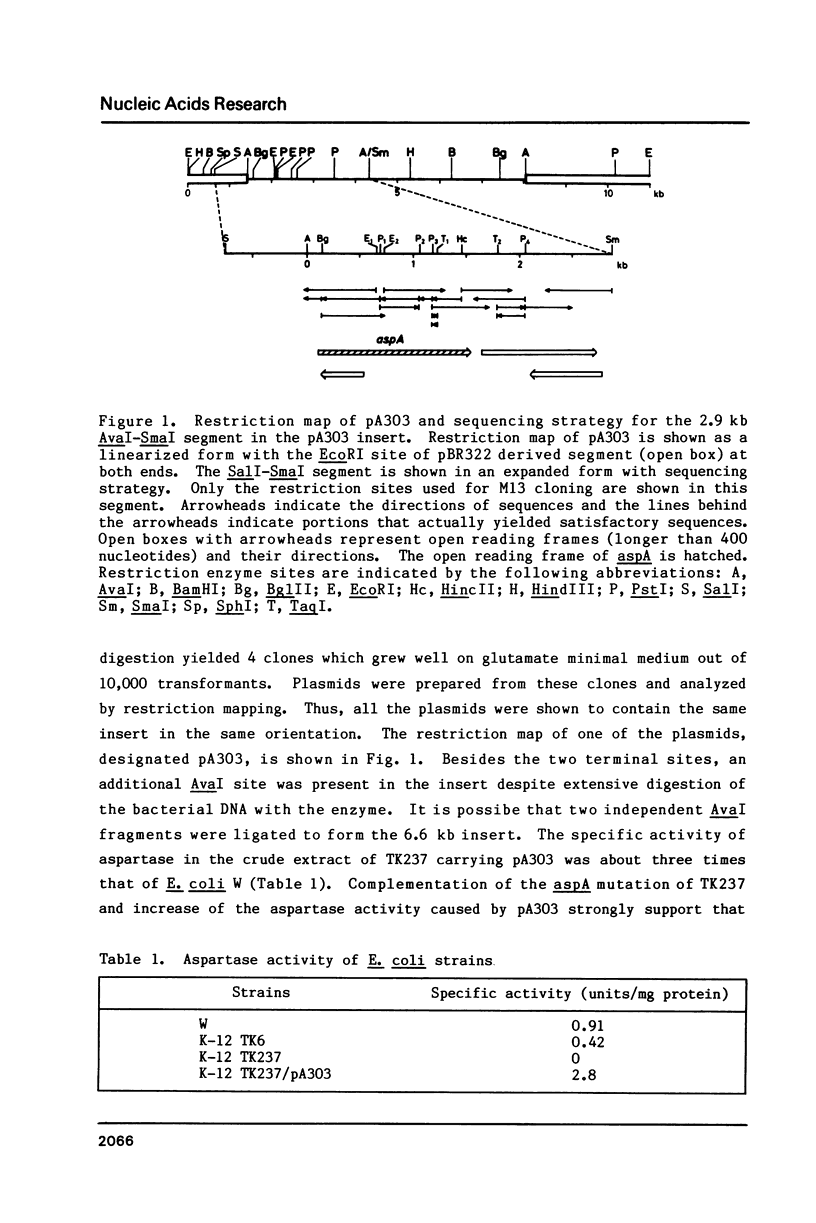
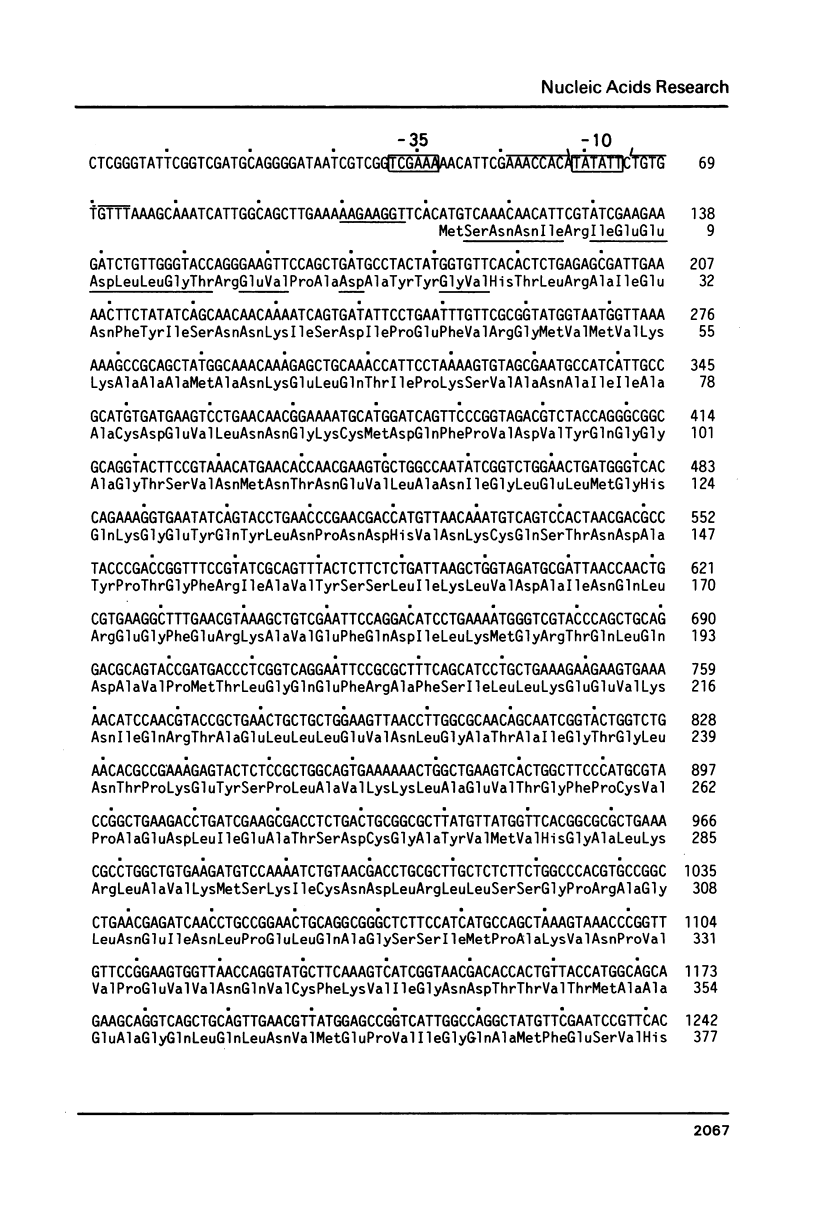
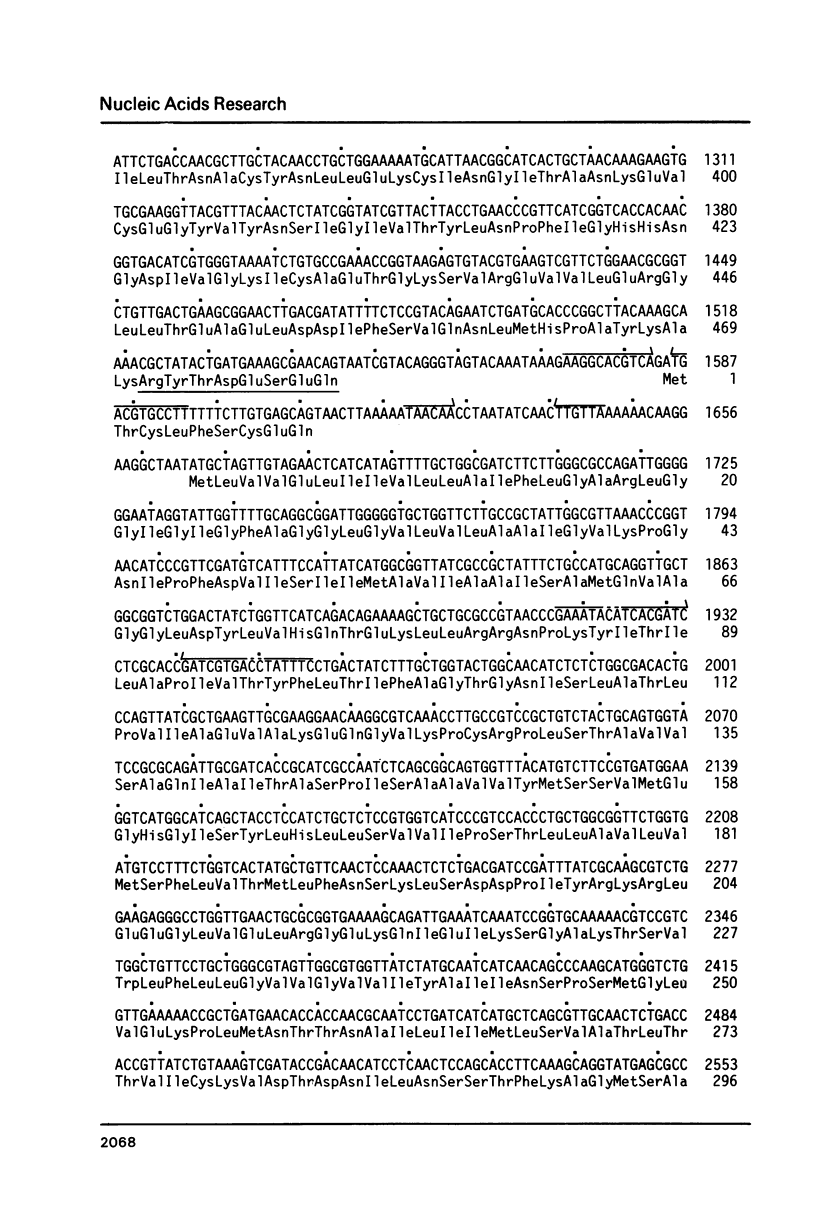
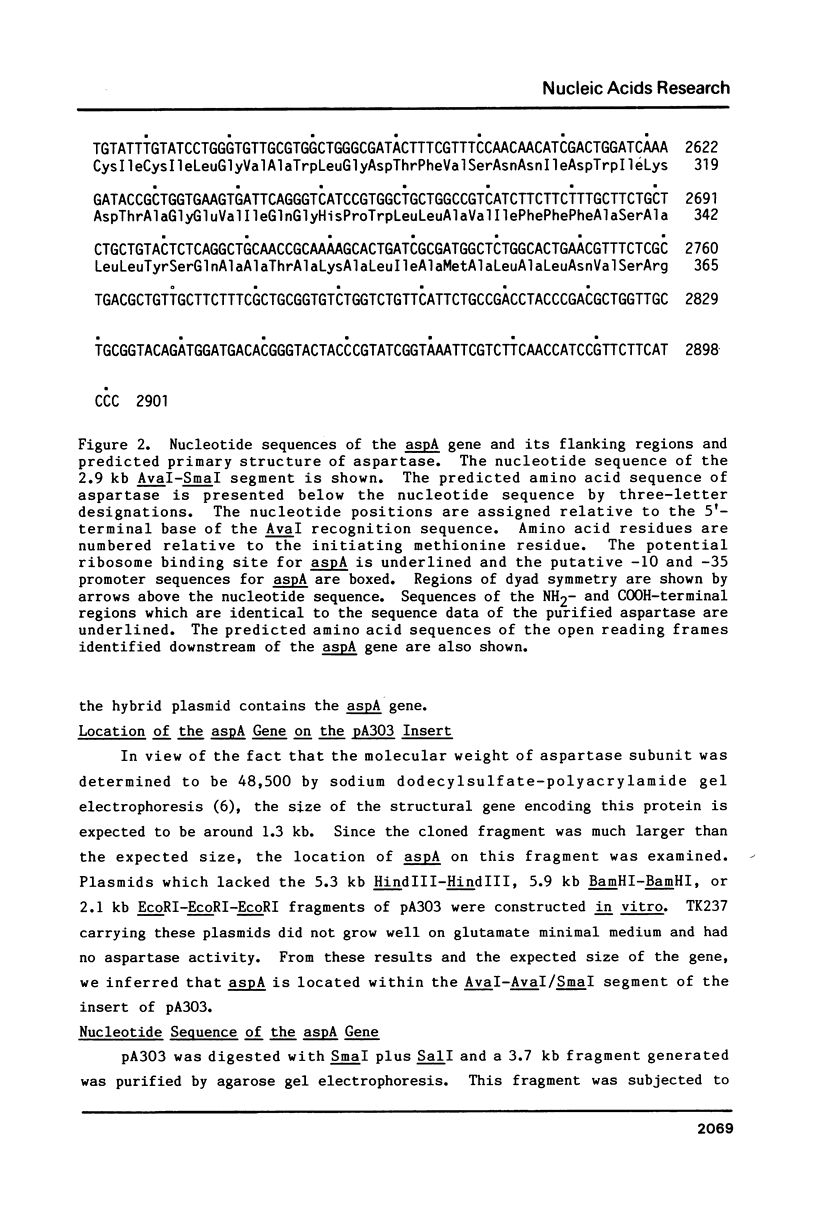
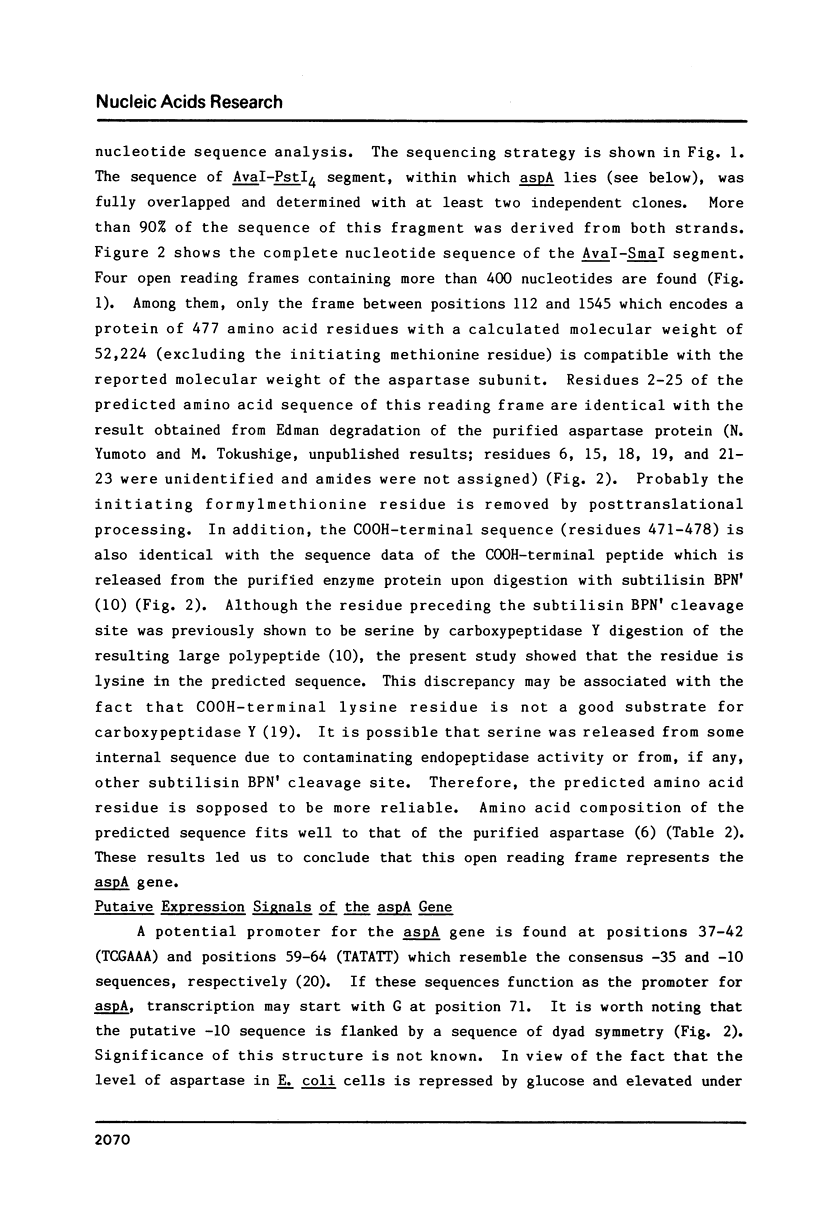
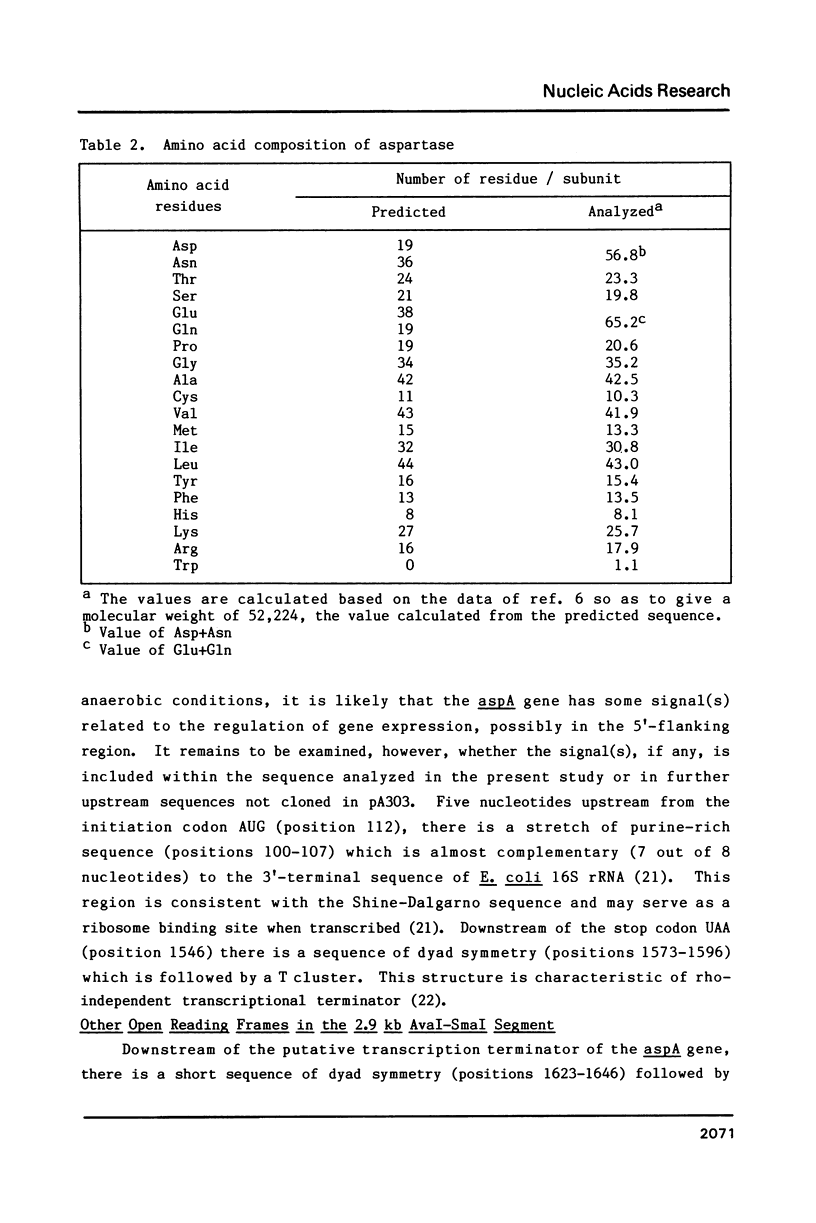
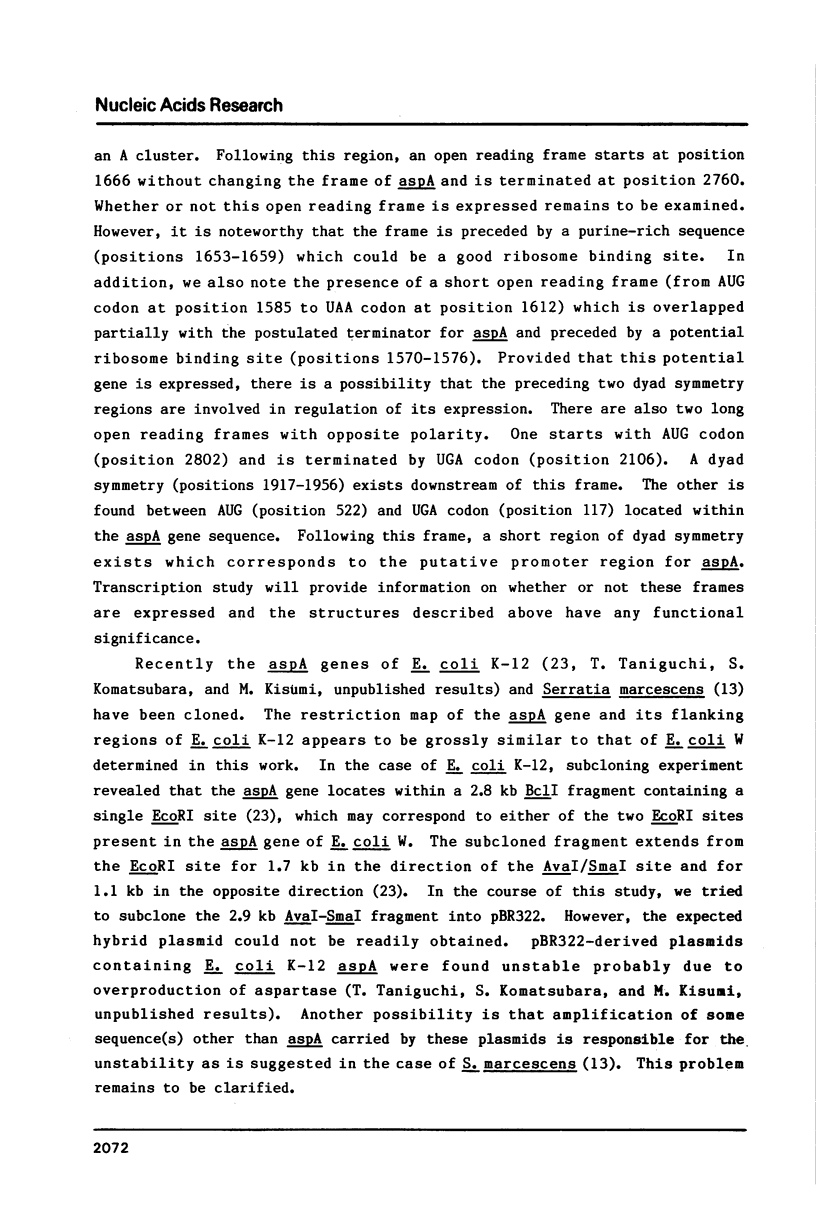
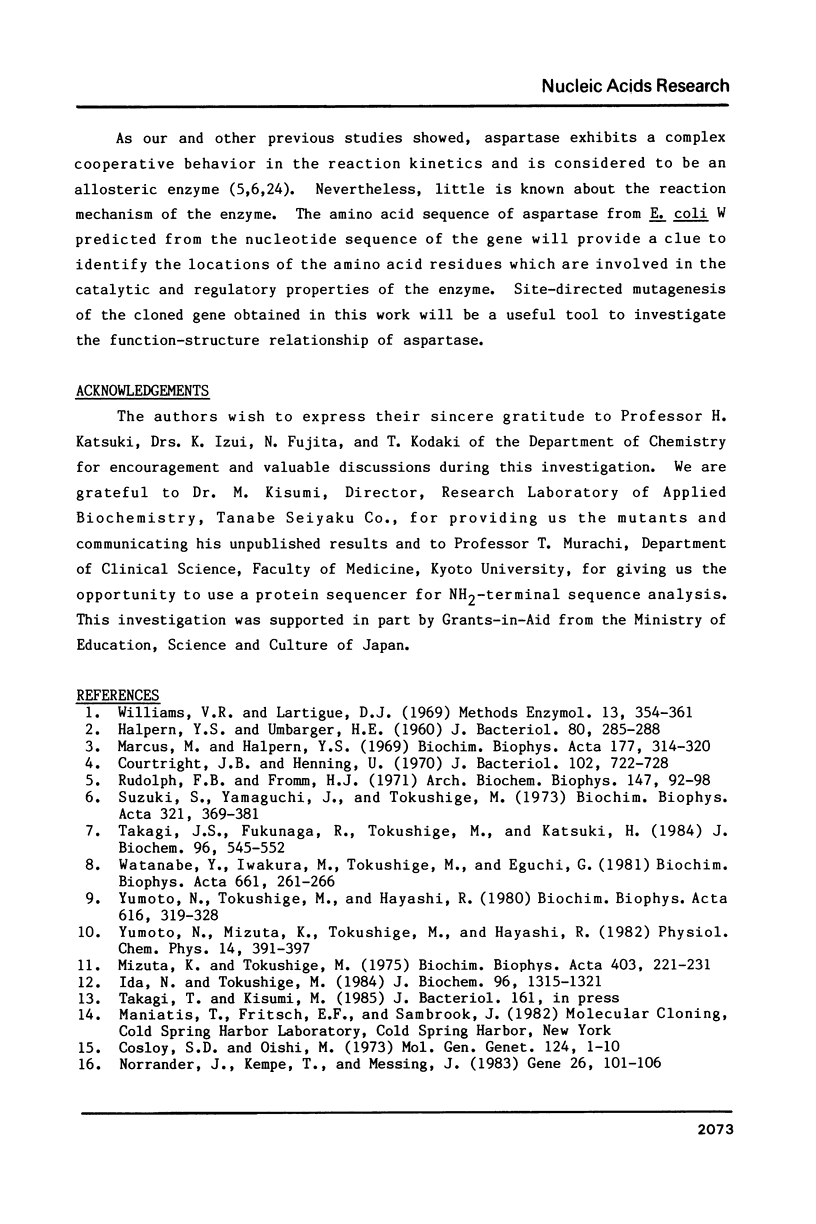
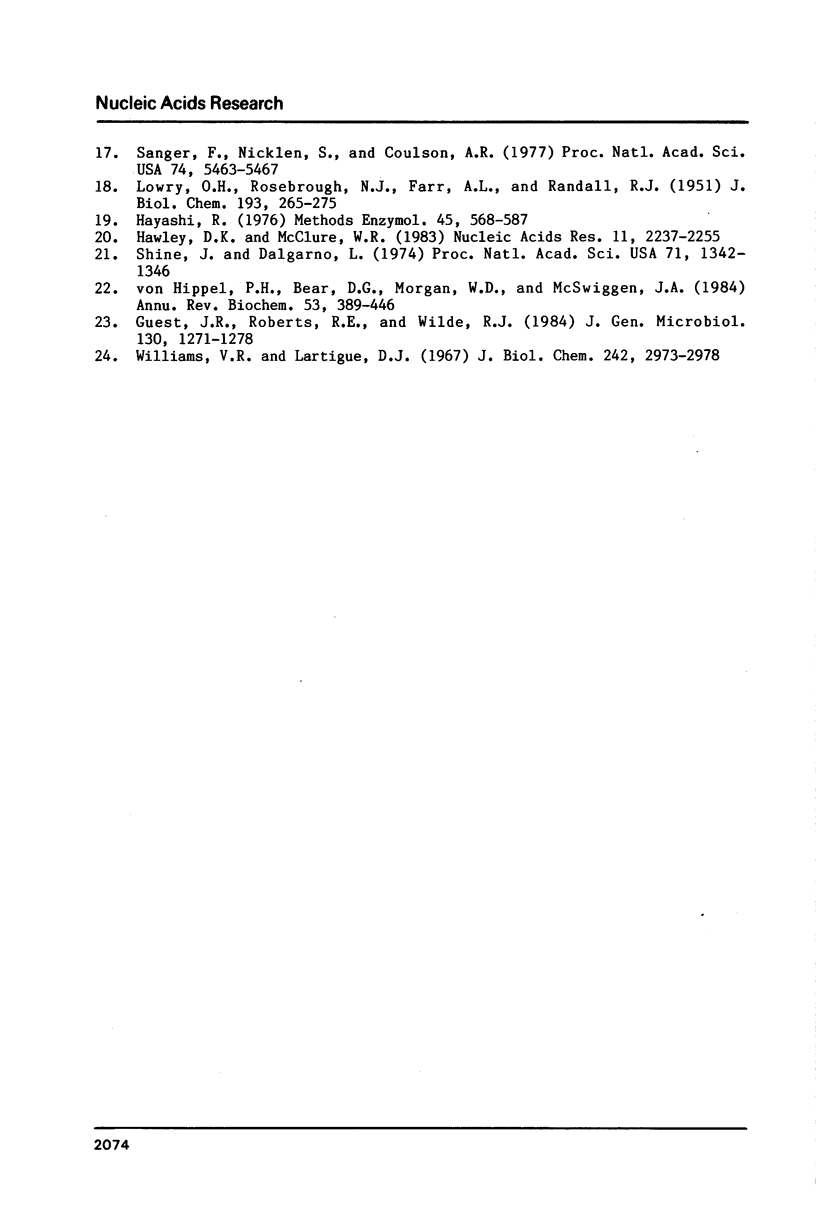
Selected References
These references are in PubMed. This may not be the complete list of references from this article.
- Cosloy S. D., Oishi M. The nature of the transformation process in Escherichia coli K12. Mol Gen Genet. 1973 Jul 31;124(1):1–10. doi: 10.1007/BF00267159. [DOI] [PubMed] [Google Scholar]
- Courtright J. B., Henning U. Malate dehydrogenase mutants in Escherichia coli K-12. J Bacteriol. 1970 Jun;102(3):722–728. doi: 10.1128/jb.102.3.722-728.1970. [DOI] [PMC free article] [PubMed] [Google Scholar]
- Guest J. R., Roberts R. E., Wilde R. J. Cloning of the aspartase gene (aspA) of Escherichia coli. J Gen Microbiol. 1984 May;130(5):1271–1278. doi: 10.1099/00221287-130-5-1271. [DOI] [PubMed] [Google Scholar]
- HALPERN Y. S., UMBARGER H. E. Conversion of ammonia to amino groups in Escherichia coli. J Bacteriol. 1960 Sep;80:285–288. doi: 10.1128/jb.80.3.285-288.1960. [DOI] [PMC free article] [PubMed] [Google Scholar]
- Hawley D. K., McClure W. R. Compilation and analysis of Escherichia coli promoter DNA sequences. Nucleic Acids Res. 1983 Apr 25;11(8):2237–2255. doi: 10.1093/nar/11.8.2237. [DOI] [PMC free article] [PubMed] [Google Scholar]
- Hayashi R. Carboxypeptidase Y. Methods Enzymol. 1976;45:568–587. doi: 10.1016/s0076-6879(76)45051-6. [DOI] [PubMed] [Google Scholar]
- Ida N., Tokushige M. Chemical modification of essential histidine residues in aspartase with diethylpyrocarbonate. J Biochem. 1984 Nov;96(5):1315–1321. doi: 10.1093/oxfordjournals.jbchem.a134959. [DOI] [PubMed] [Google Scholar]
- LOWRY O. H., ROSEBROUGH N. J., FARR A. L., RANDALL R. J. Protein measurement with the Folin phenol reagent. J Biol Chem. 1951 Nov;193(1):265–275. [PubMed] [Google Scholar]
- Marcus M., Halpern Y. S. The metabolic pathway of glutamate in Escherichia coli K-12. Biochim Biophys Acta. 1969 Apr 1;177(2):314–320. doi: 10.1016/0304-4165(69)90141-x. [DOI] [PubMed] [Google Scholar]
- Mizuta K., Tokushige M. Studies on aspartase. II. Role of sulfhydryl groups in aspartase from Escherichia coli. Biochim Biophys Acta. 1975 Sep 22;403(1):221–231. doi: 10.1016/0005-2744(75)90024-8. [DOI] [PubMed] [Google Scholar]
- Norrander J., Kempe T., Messing J. Construction of improved M13 vectors using oligodeoxynucleotide-directed mutagenesis. Gene. 1983 Dec;26(1):101–106. doi: 10.1016/0378-1119(83)90040-9. [DOI] [PubMed] [Google Scholar]
- Rudolph F. B., Fromm H. J. The purification and properties of aspartase from Escherichia coli. Arch Biochem Biophys. 1971 Nov;147(1):92–98. doi: 10.1016/0003-9861(71)90313-4. [DOI] [PubMed] [Google Scholar]
- Sanger F., Nicklen S., Coulson A. R. DNA sequencing with chain-terminating inhibitors. Proc Natl Acad Sci U S A. 1977 Dec;74(12):5463–5467. doi: 10.1073/pnas.74.12.5463. [DOI] [PMC free article] [PubMed] [Google Scholar]
- Shine J., Dalgarno L. The 3'-terminal sequence of Escherichia coli 16S ribosomal RNA: complementarity to nonsense triplets and ribosome binding sites. Proc Natl Acad Sci U S A. 1974 Apr;71(4):1342–1346. doi: 10.1073/pnas.71.4.1342. [DOI] [PMC free article] [PubMed] [Google Scholar]
- Suzuki S., Yamaguchi J., Tokushige M. Studies on aspartase. I. Purification and molecular properties of aspartase from Escherichia coli. Biochim Biophys Acta. 1973 Sep 15;321(1):369–381. doi: 10.1016/0005-2744(73)90092-2. [DOI] [PubMed] [Google Scholar]
- Takagi J. S., Fukunaga R., Tokushige M., Katsuki H. Purification, crystallization, and molecular properties of aspartase from Pseudomonas fluorescens. J Biochem. 1984 Aug;96(2):545–552. doi: 10.1093/oxfordjournals.jbchem.a134866. [DOI] [PubMed] [Google Scholar]
- Watanabe Y., Iwakura M., Tokushige M., Eguchi G. Studies on aspartase. VII. Subunit arrangement of Escherichia coli aspartase. Biochim Biophys Acta. 1981 Oct 13;661(2):261–266. doi: 10.1016/0005-2744(81)90013-9. [DOI] [PubMed] [Google Scholar]
- Williams V. R., Lartigue D. J. Quaternary structure and certain allosteric properties of aspartase. J Biol Chem. 1967 Jun 25;242(12):2973–2978. [PubMed] [Google Scholar]
- Yumoto N., Mizuta K., Tokushige M., Hayashi R. Studies on aspartase VIII. Protease-mediated activation: comparative survey of protease specificity for activation and peptide cleavage. Physiol Chem Phys. 1982;14(4):391–397. [PubMed] [Google Scholar]
- Yumoto N., Tokushige M., Hayashi R. Studies on aspartase. VI. Trypsin-mediated activation releasing carboxy-terminal peptides. Biochim Biophys Acta. 1980 Dec 4;616(2):319–328. doi: 10.1016/0005-2744(80)90149-7. [DOI] [PubMed] [Google Scholar]
- von Hippel P. H., Bear D. G., Morgan W. D., McSwiggen J. A. Protein-nucleic acid interactions in transcription: a molecular analysis. Annu Rev Biochem. 1984;53:389–446. doi: 10.1146/annurev.bi.53.070184.002133. [DOI] [PubMed] [Google Scholar]


